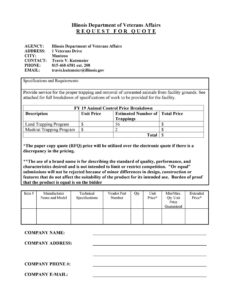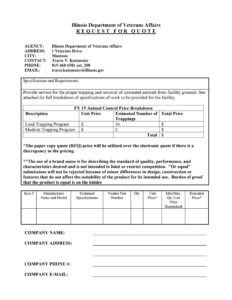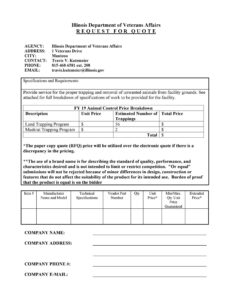Utilizing such a form offers several advantages. It saves time by providing a pre-defined format, eliminating the need to draft individual requests from scratch. This standardization also promotes fairness and transparency in the bidding process, ensuring all vendors receive the same information. Ultimately, this process facilitates informed decision-making, leading to cost savings and improved vendor relationships.
This article will delve into the essential components of these forms, best practices for their creation and usage, and examples demonstrating effective implementation. Further discussion will explore how these forms integrate into broader procurement strategies and contribute to overall organizational efficiency.
Key Components of a Price Quote Request
Effective price quote requests require specific information to ensure clarity and facilitate accurate vendor responses. The following components are essential for a comprehensive and useful document.
1. Requestor Information: Clear identification of the requesting organization, including full name, address, and contact details ensures vendors can readily respond and direct inquiries appropriately.
2. Vendor Information: Space for the vendor’s name, address, and contact information allows for easy record-keeping and communication.
3. Date of Request: Including the date establishes a timeframe for the quote’s validity and allows for tracking of responses.
4. Product/Service Description: Detailed specifications of the required items or services are crucial. This includes precise descriptions, quantities, units of measure, and any relevant technical specifications or drawings.
5. Delivery Requirements: Expected delivery date, location, and any specific shipping instructions ensure alignment between requestor needs and vendor capabilities.
6. Payment Terms: Clearly stating accepted payment methods, credit terms, and any applicable discounts promotes transparency and facilitates smooth transactions.
7. Validity Period: Specifying the timeframe for which the quote remains valid allows for effective comparison and decision-making within a defined period.
8. Submission Instructions: Clear instructions on how and where to submit the quote, including deadlines and preferred formats (e.g., email, online portal), streamline the response process.
A well-structured form containing these elements promotes efficient communication between buyers and sellers, leading to a more streamlined procurement process and informed purchasing decisions. Accurate and complete information minimizes potential misunderstandings and ensures all parties are working with the same expectations.
How to Create a Request for Price Quote Template
Developing a standardized template ensures consistency and efficiency in the procurement process. A well-crafted template facilitates clear communication with vendors and enables effective comparison of bids. The following steps outline the process of creating a robust and effective template.
1. Define Required Information: Identify the essential data points needed for informed decision-making. This includes details about the requesting organization, the vendor, product/service specifications, delivery requirements, payment terms, and submission instructions.
2. Choose a Format: Select a suitable format, such as a spreadsheet, word processing document, or online form. Consider factors like ease of use, compatibility with existing systems, and the ability to track and manage responses.
3. Structure the Template: Organize the template logically, grouping related information together. Use clear headings and labels to ensure readability and facilitate efficient completion by vendors.
4. Incorporate Standard Clauses: Include standard legal and commercial terms and conditions to protect organizational interests and clarify expectations regarding warranties, liabilities, and dispute resolution.
5. Implement Version Control: Establish a version control system to track changes and ensure all stakeholders are using the most current template. This prevents confusion and maintains consistency across requests.
6. Test and Refine: Pilot test the template with a small group of vendors to gather feedback and identify areas for improvement. Refine the template based on this feedback to optimize its effectiveness.
A well-designed template streamlines communication, promotes transparency, and ultimately contributes to cost savings and stronger vendor relationships. Regular review and updates ensure the template remains aligned with evolving organizational needs and industry best practices.
Standardized forms for soliciting pricing information are essential tools for efficient procurement. These forms ensure clarity, consistency, and transparency in communication between buyers and sellers. Key components such as detailed product specifications, delivery requirements, and payment terms enable informed decision-making and minimize potential misunderstandings. A well-defined creation process, incorporating version control and ongoing refinement, ensures the template remains effective and aligned with organizational needs.
Leveraging a structured approach to price quote requests empowers organizations to optimize vendor selection, negotiate favorable terms, and ultimately contribute to cost savings and improved bottom-line performance. Continuous improvement of these processes, informed by best practices and evolving market dynamics, represents a critical element of strategic procurement and long-term organizational success.


